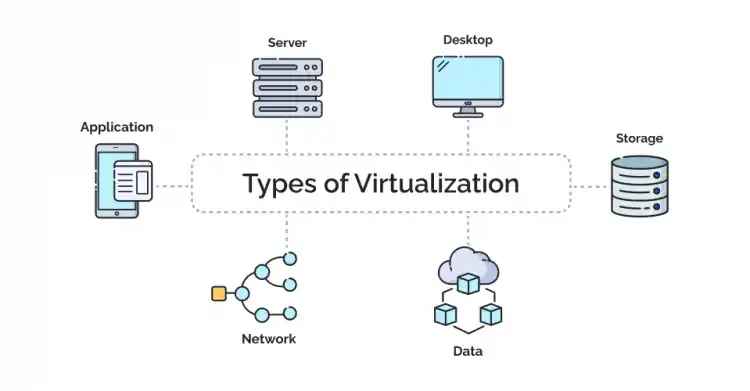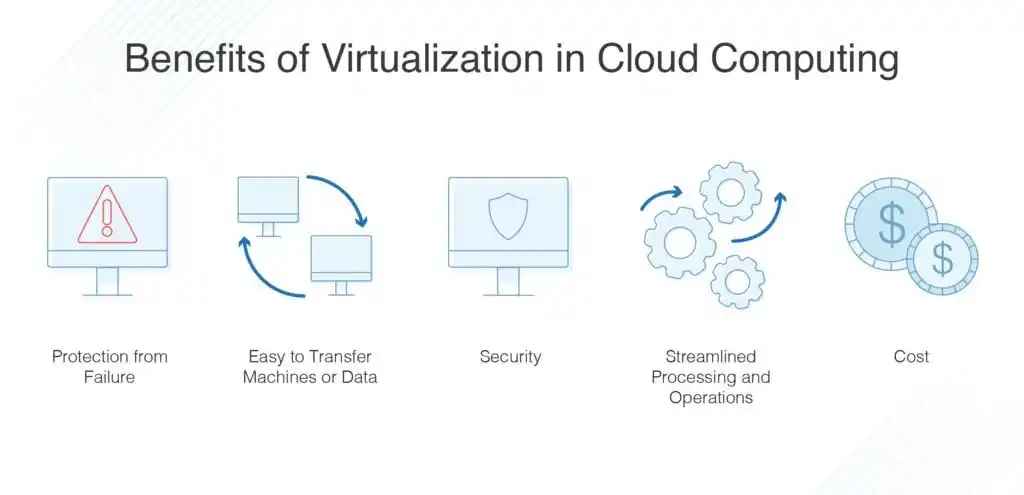Revolutionizing Business with Virtualization in Cloud
Updated on : 03 April 2025

Image Source: google.com
Table Of Contents
- 1. Introduction
- 2. What is Virtualization ?
- 3. The Concept of Virtualization in Cloud Computing
- 4. Key Characteristics of Virtualization
- 5. Types of Virtualization in Cloud Computing
- 6. Application Virtualization
- 7. Operating System (OS) Virtualization
- 8. Storage and Server Virtualization
- 9. Administrative and Desktop Virtualization
- 10. Benefits of Virtualization in Cloud Computing
- 11. Cost Efficiency and Failure Protection
- 12. Adopting Virtualization for Your Cloud Network
- 13. FAQs
Table Of Contents
Introduction
Virtualization in the cloud is redefining business operations, offering unmatched flexibility, cost efficiency, and scalability. By optimizing resources, enhancing security, and enabling remote access, it empowers businesses to innovate, adapt, and grow faster in the digital era. The future is virtual.
What is Virtualization ?

Image Source: google
-
Definition – Virtualization is the process of creating virtual versions of physical hardware, servers, storage, or networks to optimize resource utilization.
-
How It Works – Uses software called a hypervisor to create and manage virtual machines (VMs) on a single physical server.
-
Types of Virtualization – Includes server, network, storage, desktop, application, and data virtualization.
-
Key Benefits – Enhances scalability, cost savings, efficiency, security, and disaster recovery capabilities.
-
Virtual Machines (VMs) – Independent OS instances run on shared hardware, improving flexibility and reducing hardware dependency.
The Concept of Virtualization in Cloud Computing
| Concept | Description |
|---|---|
| Virtual Machines (VMs) | Software-based computers running multiple OS on a single physical server. |
| Containers | Lightweight, isolated environments sharing the same OS kernel for efficient deployment. |
| Hypervisors | Software that creates and manages virtual machines on physical hardware. |
| Network Virtualization | Combining network resources into a single, software-based infrastructure. |
| Storage Virtualization | Pooling storage from multiple devices into a unified system for better management. |
Key Characteristics of Virtualization
| Key Characteristic | Description |
|---|---|
| Resource Pooling | Combines computing resources to serve multiple users efficiently. |
| Hardware Independence | Allows software to run on different physical machines without modification. |
| Isolation | Separates virtual environments to prevent interference between them. |
| Scalability | Easily increases or decreases resources based on demand. |
| Snapshot & Backup | Enables quick restoration by saving system states. |
| Cost Efficiency | Reduces hardware and maintenance costs through optimized resource use. |
Optimize, Secure, and Scale with Hexadecimal’s Google Cloud Solutions
Types of Virtualization in Cloud Computing

Image Source: google
-
Server Virtualization – Divides a single physical server into multiple virtual servers, improving resource utilization and efficiency.
-
Storage Virtualization – Combines multiple physical storage devices into a single, centralized storage system for better management and scalability.
-
Network Virtualization – Creates virtual networks that operate independently on the same physical network, enhancing flexibility and security.
-
Desktop Virtualization – Enables users to access a virtual desktop environment remotely from any device, improving mobility and security.
-
Application Virtualization – Runs applications in isolated environments without installation on the local device, reducing compatibility issues.
-
Data Virtualization – Integrates data from multiple sources into a single virtual view, enabling real-time access without data duplication.
Application Virtualization
| Application Virtualization | Description |
|---|---|
| What is it? | Runs apps in a virtual environment, separate from the OS. |
| Benefits | Enhances security, reduces compatibility issues, and simplifies management. |
| Use Cases | Ideal for remote work, software testing, and centralized IT control. |
| Popular Tools | Microsoft App-V, VMware ThinApp, Citrix Virtual Apps. |
Operating System (OS) Virtualization
| OS Virtualization Type | Description |
|---|---|
| Hypervisor-Based Virtualization | Uses a hypervisor (like VMware, Hyper-V) to run multiple OS instances on a single physical machine. |
| Containerization | Lightweight OS virtualization (e.g., Docker, Kubernetes) where apps run in isolated environments. |
| Server Virtualization | Partitions a physical server into multiple virtual servers to optimize resource usage. |
| Desktop Virtualization | Allows remote access to virtual desktops hosted on a central server. |
| Application Virtualization | Runs applications in isolated environments without installing them on the host OS. |
Storage and Server Virtualization
| Virtualization Type | Storage Virtualization | Server Virtualization |
|---|---|---|
| Description | Combines multiple storage devices into a single system for better management and efficiency (e.g., SAN, NAS). | Divides a physical server into multiple virtual servers using a hypervisor to optimize resource usage. |
Administrative and Desktop Virtualization

Looking to Integrate Advanced Solutions into Your Cloud Computing Strategy?
Administrative
-
Centralized management of IT resources, such as servers, storage, and networks.
-
Uses virtualization technologies to control and monitor infrastructure remotely.
-
Improves security, reduces hardware dependency, and enhances scalability.
-
Examples: Virtualized network management, cloud-based IT administration.
Desktop Virtualization
-
Allows users to access virtual desktops remotely from any device.
-
Enhances security by keeping data on a central server rather than local machines.
-
Reduces IT maintenance costs and supports flexible work environments.
-
Examples: Virtual Desktop Infrastructure (VDI), Remote Desktop Services (RDS).
Benefits of Virtualization in Cloud Computing

Image Source: google
-
Cost Efficiency – Reduces hardware costs by running multiple virtual machines on a single physical server.
-
Resource Optimization – Maximizes the utilization of computing resources by dynamically allocating them as needed.
-
Scalability – Easily scales up or down based on demand without requiring additional physical infrastructure.
-
Disaster Recovery – Simplifies backup and recovery processes by creating virtual machine snapshots.
-
Enhanced Security – Isolates virtual machines to prevent security breaches and data leaks.
-
Faster Deployment – Speeds up application and server deployment through pre-configured virtual environments.
-
Energy Efficiency – Reduces power consumption by consolidating multiple workloads onto fewer servers.
-
Flexibility & Mobility – Allows users to access virtualized environments from anywhere, improving remote work capabilities.
Cost Efficiency and Failure Protection

Ready to Take Your Mobile App to the Next Level with Cutting-Edge Solutions?
| Strategy | Description |
|---|---|
| Cloud Computing | Reduces infrastructure costs and ensures scalability on demand. |
| Open-Source Tools | Leverages free software to cut development and maintenance expenses. |
| Automated Testing | Detects issues early, reducing failure risks and debugging costs. |
| Load Balancing | Distributes traffic efficiently to prevent downtime and failures. |
| Disaster Recovery Plans | Ensures data backups and quick recovery in case of failures. |
Adopting Virtualization for Your Cloud Network

Image Source: google
| Virtualization Strategy | Description |
|---|---|
| Virtual Machines (VMs) | Run multiple OS instances on a single physical server for better resource use. |
| Containers | Lightweight, portable environments for efficient app deployment and scaling. |
| Software-Defined Networking (SDN) | Centralized control of network traffic for flexibility and automation. |
| Network Function Virtualization (NFV) | Replace hardware-based network functions with virtualized solutions. |
| Hybrid & Multi-Cloud | Combine private and public cloud resources for optimized performance and cost. |
FAQs
Q.1. What is virtualization in cloud computing?
A: Virtualization allows businesses to run multiple virtual instances (VMs or containers) on a single physical server, optimizing resource usage and scalability.
Q.2. How does virtualization benefit businesses?
A: It reduces hardware costs, improves flexibility, enhances disaster recovery, and enables efficient resource management.
Q.3. What are common types of virtualization?
A: Server Virtualization: Multiple virtual servers on one physical machine.A: Network Virtualization: Software-based control of networking resources.A: Storage Virtualization: Pooling multiple storage devices into a single unit.Q.4. What is the difference between VMs and containers?
A: VMs run full OS instances, while containers share the host OS kernel, making them lighter and faster.
Q.5. Is cloud virtualization secure?
A: Yes, with proper security measures like encryption, access controls, and regular updates, cloud virtualization is highly secure.
Q.6. How does virtualization support hybrid and multi-cloud environments?
A: It enables seamless integration between private and public clouds, allowing businesses to optimize costs and performance.
Q.7. What is Software-Defined Networking (SDN)?
A: SDN centralizes network management, allowing dynamic control of traffic and improved efficiency.
Q.8. How can businesses get started with virtualization?
A: Start by assessing current infrastructure, choosing a virtualization platform (VMware, Hyper-V, Kubernetes, etc.), and gradually migrating workloads to the cloud.


